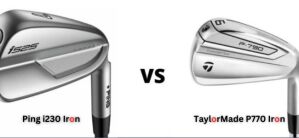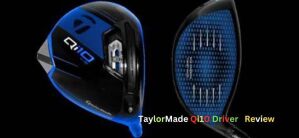Ping i230 Vs P770 TaylorMade Irons: A Comprehensive Comparison

Last Updated on May 1, 2024 by Daniel
For seasoned golfers eyeing new irons, the Ping i230 Vs P770 TaylorMade Irons stand out. Both lauded for performance, but what sets them apart? A thorough test at Princess Golf Club reveals insights.
Table of Contents
Ping i230 Vs P770 TaylorMade Irons: Design and Construction

TaylorMade P770
The P770’s outward appearance mimics a blade but conceals a hollow body construction packed with technological marvels. Tungsten strategically placed within enhances forgiveness and elevates launch, complemented by the infusion of speed foam in the cavity. This intricate design aims to dampen vibrations, refining the overall feel.
Ping i-230
In contrast, the Ping i-230 embodies a traditional cavity back design veiled by a multi-material badge. Its construction features a toaster-style slot with activated elastomer behind the face. This amalgamation shaves weight, allowing strategic redistribution for heightened forgiveness, aided by tungsten toe and tip weights.
The distinctive construction of both models promises a fusion of forgiveness and stability within a compact framework.
Ping i230 Vs P770 TaylorMade Irons: On-Course Performance Analysis

Visual Appeal
In the realm of aesthetics, the P770 flaunts a captivating exterior, enticing with its shelf appeal. Conversely, the Ping i-230 exudes simplicity, a trait valued by certain golfers. The visual preference becomes subjective, intertwined with personal inclinations.
Size and Confidence
Size plays a pivotal role. The Ping i-230’s substantial presence inspires confidence during address, especially for those favoring traditionally lofted irons. Its white bottom groove aids alignment, augmenting the visual aid during setup. Conversely, the compactness of the P770 might appeal to players seeking a more refined, sleek appearance.
Forgiveness and Turf Interaction
The wider sole width of the Ping i-230 hints at increased forgiveness through the turf, despite its visual appearance. Contrarily, the P770, albeit compact, offers a different turf impact, accentuated by its bridge design.
Sound and Feel
Hitting shots with both models unveils their distinct auditory and tactile signatures. The P770 resonates with a metallic spring yet retains a touch of softness. On the other hand, the i-230 emits a softer thud, resonating stability upon impact. Both irons display liveliness off the face, but the subtle differences in sound and feel can sway individual preferences.
Performance Analysis
The crunching numbers from the GC Quad launch monitor showcase strikingly similar performance metrics between the two models. Consistent carry distances around the 160-yard mark and spinning rates hovering at 6000 RPM highlight the minimal tangible differences. However, nuances in launch and ball flight set them apart, influencing individual preferences.
Final Verdict
On the golf course, the Ping i-230 showcases slightly superior stability in ball flight, veering less offline compared to the P770, especially in long irons. The i-230’s larger size, though slimmed down, offers heightened confidence, particularly in extended irons.
In the realm of feel, the Ping i-230’s softer touch garners preference. It encapsulates a user-friendly package with a touch of finesse, making it a compelling choice.
While both models excel, the Ping i-230 emerges as a slightly more versatile option, offering a bit more for its price point. Its compatibility for customization and forgiveness across the spectrum make it an enticing pick.
Conclusion
As the curtain falls on this comparison, the choice between the P770 and the Ping i-230 transcends mere numbers. It’s a dance between personal inclinations, visual appeal, and nuanced performance on the green. For those seeking compact finesse without compromising forgiveness, the Ping i-230 stands tall. Conversely, if a sleek, refined profile beckons, the P770 won’t disappoint.
Your choice echoes your style, your game, and your affinity. Let your swing guide your decision, and may the right iron amplify your prowess on the fairway.
Thank you for joining us on this journey through the realms of golfing precision. Until next time, may your swings be steady, and your putts be true.







